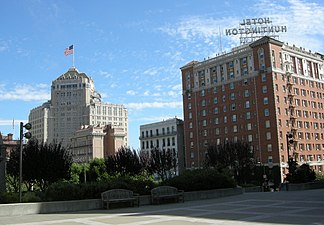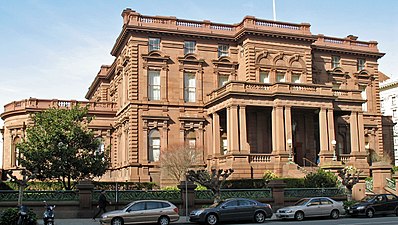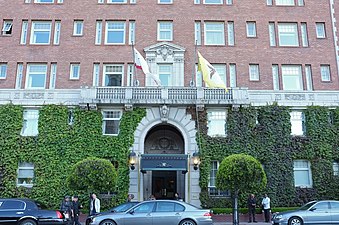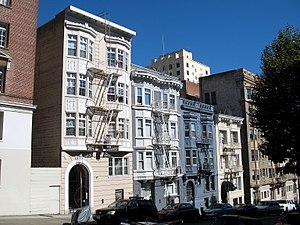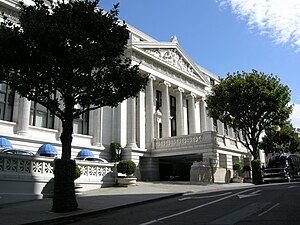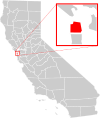Nob Hill
Nob Hill is a luxury destination in San Francisco, owing to its numerous Michelin-starred restaurants, boutiques, cultural institutions, art galleries, and historic landmarks. The neighborhood is named after one of San Francisco's original "Seven Hills" and it contains the Lower Nob Hill Apartment Hotel District (also known as Lower Nob Hill).
Location



The actual peak of Nob Hill lies approximately at the intersection of Jones and Sacramento Streets.
North of Nob Hill is Russian Hill. West of the district is Pacific Heights. To the south of Nob Hill is the Union Square shopping district, Civic Center district, and the Tendernob neighborhood. East of Nob Hill is Chinatown and the Financial District. Northeast of Nob Hill is North Beach and Telegraph Hill.
The Polk Gulch area comprises the westernmost portions of Nob Hill and Russian Hill. The southern portion of Nob Hill is known as Lower Nob Hill. On its southwest slope, the area in between Nob Hill and the Tenderloin neighborhood is an area known as the Tendernob.

History
Prior to the 1850s, Nob Hill was called California Hill (after California Street, which climbs its steep eastern face), but was renamed after the Central Pacific Railroad's Big Four – known as the Nobs – who built their mansions on the hill.
The area was settled in the rapid urbanization happening in the city in the late 19th century. Because of the views and its central position, it became an exclusive enclave of the rich and famous on the west coast who built large mansions in the neighborhood. This included prominent tycoons such as Leland Stanford, founder of Stanford University and other members of The Big Four. These early citizens were known as nabobs, a term for prominent and wealthy men. This was shortened to nob, probably the origin of the area's eventual name.
The neighborhood was destroyed in the 1906 earthquake and fire, except for the granite walls surrounding the Stanford, Crocker, Huntington and Hopkins mansions. These walls remain and black scars caused by smoke from the intense fires that burned after the quake can still be seen.
Also gutted by the fires was the newly completed Fairmont Hotel at Mason and California Streets, as well as the mansion of tycoon James Clair Flood. Both structures had stone exteriors that survived the fires, and both buildings were subsequently cleaned and refurbished. The Fairmont Hotel remains in operation to this day and the Flood Mansion is the headquarters of the exclusive Pacific-Union Club.
While the neighborhood was able to maintain its affluence following the quake, every mansion owner moved or rebuilt elsewhere. Some rebuilt mansions further west in San Francisco, for example, in Pacific Heights and Cow Hollow. In place of where the mansions had been located, swank hotels were erected. Hotels built over the ruins of the former mansions include the Mark Hopkins, Huntington and Stanford Court.
Characteristics
Nob Hill is an affluent district, home to many of the city's upper-class families as well as a large young urban professional population, and a growing Chinese immigrant population from Chinatown to the east.
Four of San Francisco's well-known and most expensive hotels are located on Nob Hill, along California Street: the Mark Hopkins Hotel, the Stanford Court, the Huntington Hotel, and the Fairmont Hotel. The hotels were named for San Francisco tycoons Mark Hopkins, Leland Stanford, & Collis Potter Huntington — three of the Big Four entrepreneurs of the construction of the Central Pacific Railroad — and James Graham Fair, respectively.
Opposite the Fairmont Hotel and Pacific Union Club is Grace Cathedral, one of the city's largest houses of worship.
The Grand Lodge of California's headquarters are the SF Masonic Auditorium.
In Lower Nob Hill, the Academy of Art University owns and operates several buildings for housing and educational opportunities.
Also in lower Nob Hill, on Bush Street, are the Memorial Home of Fire Chief Dennis T. Sullivan and the sister hotels, the White Swan Inn and Petite Auberge.
Parks
There are numerous historic and well maintained parks throughout Nob Hill. The most prominent park in the neighborhood is Huntington Park, which takes up an entire block, bounded by Sacramento Street to the north, Taylor Street to the west, California Street to the south, and Cushman Street to the east. Huntington Park was formerly the site of the mansion of Central Pacific Railroad baron Collis Potter Huntington; the mansion was destroyed by the 1906 earthquake and fire, however, and Huntington's widow donated the property to the city to establish a park in 1915. Huntington Park has a playground for children, landscaping, and several fountains.
Washington & Hyde Mini Park is situated on a single lot between two apartment buildings on the north side of Washington Street, between Hyde Street and Leavenworth Street. Washington & Hyde Mini Park has a playground for children and landscaping.
Gallery
-
Dancing Sprites by Henri-Léon Gréber
-
The Mark Hopkins Hotel and Huntington Hotel
-
Fontana delle Tartarughe in Huntington Park
-
Lower Nob Hill Apartment Hotel Historic District
-
Brockelbank Apartments
-
Mark Hopkins mansion.
See also
References
- ^ "Statewide Database". UC Regents. Archived from the original on February 1, 2015. Retrieved December 8, 2014.
- ^ "California's 11th Congressional District - Representatives & District Map". Civic Impulse, LLC.
- ^ "Nob Hill neighborhood". City-Data. Retrieved December 10, 2014.
- ^ Tarver, Evan (March 7, 2020). "The Most Expensive Neighborhoods in San Francisco". Investopedia. Archived from the original on April 10, 2021.
- ^ "Best Neighborhood to Stay in San Francisco". San Francisco Travel. March 9, 2020.
- ^ Weinberger, Matt (May 16, 2016). "The 23 neighborhoods in San Francisco where you'd pay $1 million or more for a home". Business Insider.
- ^ Sotheby's International Realty – Nob Hill of San Francisco
- ^ Mendelsohn, Hadley (June 18, 2019). "17 SF Neighborhoods That Make Us Want to Move There, Like, Yesterday". MyDomaine. Archived from the original on September 25, 2020.
- ^ Kolmar, Chris (December 20, 2017). "These Are The 10 Best Neighborhoods In San Francisco, CA For 2018". HomeSnacks. Archived from the original on September 17, 2018.
- ^ "San Francisco Home Listings Down 40% as 'Mortgage Lock-In' Scares off Sellers". May 11, 2023.
- ^ "Bay Area housing market — once fueled by tech — cools amid layoffs". June 9, 2023.
- ^ Fort, Ellen (October 31, 2017). "San Francisco's 2018 Michelin Stars, Mapped". Eater SF. Archived from the original on March 5, 2018.
- ^ Shoot, Brittany (August 23, 2017). "A Local's Guide to San Francisco's Nob Hill Neighborhood". Wheretraveler.
- ^ Kuchar, Sally (October 27, 2016). "Your guide to San Francisco's Nob Hill neighborhood". Curbed SF.
- ^ Solnit, Rebecca (2003). River of Shadows: Eadweard Muybridge and the Technological Wild West. New York: Viking. p. 157. ISBN 9780670031764.
- ^ Cohen, Katherine Powell (2010). San Francisco's Nob Hill. Charleston, S.C.: Arcadia Publishing. p. 7. ISBN 978-0-7385-8128-6.
- ^ Hart, James David (1987). A Companion to California (revised ed.). University of California Press. p. 352. ISBN 0-520-05543-8.
- ^ "Academy of Art University Campus Map" (PDF). academyart.edu. Academy of Art University. Retrieved November 23, 2016.
- ^ San Francisco Landmark #42, Dennis T. Sullivan Memorial Fire Chief's Home, 870 Bush Street Between Mason and Taylor, Built 1922 – NoeHill.com
- ^ Trejos, Nancy (July 13, 2018). "Hotel renovations: Properties in Los Angeles, Dallas and San Francisco get major upgrades". USA TODAY.
- ^ "Huntington Park". Nob Hill Association.
- ^ "Washington Hyde Mini Park". ParkScan. Archived from the original on July 21, 2011.
External links
 San Francisco/Nob Hill-Russian Hill travel guide from Wikivoyage
San Francisco/Nob Hill-Russian Hill travel guide from Wikivoyage- The Nob Hill Association Nob Hill Foundation
- Nob Hill – A Touch of Class San Francisco Travel Association

